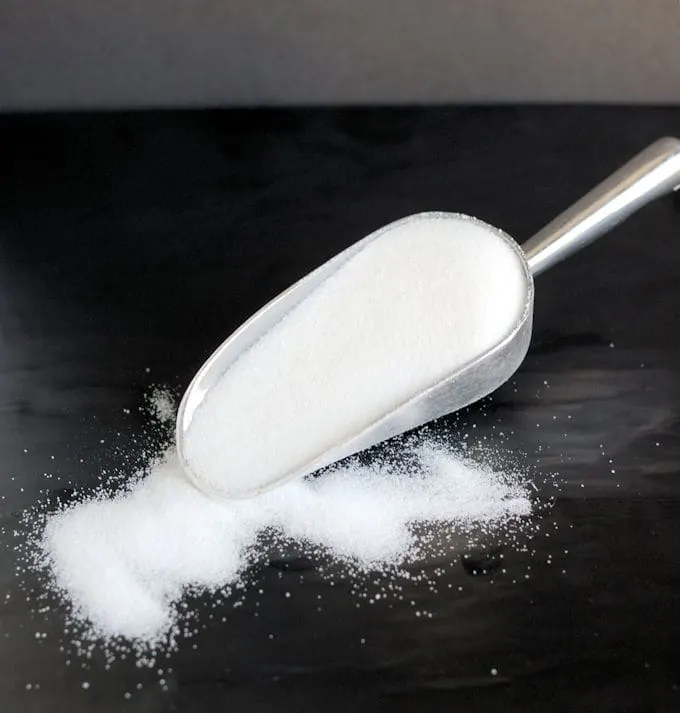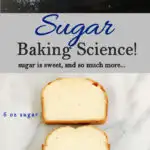The Science of Sugar in Baking
Sugar is a mainstay in the baker’s kitchen. Of course, sugar is important in the kitchen because the sweet flavor makes food delicious. We humans are programmed to like sweet.
Sweetness also balances out sour and bitter flavors in food to help create a more complex flavor. But sugar contributes much more than sweetness to your baked goods.

What Sugar does as a Baking Ingredient
Sugar is hygroscopic, meaning it has a tendency to attract and hold onto water molecules. This characteristic of sugar helps make and keep baked goods moist.
Sugar interferes with the coagulation of proteins. Adding more sugar to a recipe causes the proteins in the flour and eggs to form weaker bonds, creating a more tender, softer crumb.
What is Sugar?
All sugars, including table sugar, honey, molasses and corn syrup, are made up of molecules derived and refined from plant fluids.
The process of photosynthesis produces sugars in all plants. Cellulose, hemicellulose and pectin are made up of chains of sugar molecules and form a plant’s structure.
Bees extract juice from plants to produce honey. We extract juice from plants (mostly sugar cane and sugar beets), then process and crystallize the juice to produce table sugar.
Types of Sugar Used In Baking:
The scientific name for table sugar is sucrose. Sucrose is a double sugar (disaccharide) made up of two simple sugars (monosaccharides), glucose and fructose.
- Glucose: In the kitchen you’ll find glucose in regular corn syrup (not high fructose corn syrup, that’s something else). Glucose is less sweet than table sugar and is also less water soluble. A product made with corn syrup will be less sweet than one made with an equal amount of table sugar. Corn syrup interferes with sugar crystallization, which is why it’s often added to candies, ice cream and other products that require a smooth, non-grainy texture.
- Fructose: the other simple sugar found in sucrose, has the same chemical makeup as glucose, with a different arrangement of atoms. High fructose corn syrup is made by treating regular corn syrup with enzymes to convert the glucose in the syrup into fructose. Fructose is sweeter than glucose and is more water soluble. So high fructose corn syrup is used by commercial food producers because it has a sweeter taste than regular (glucose) corn syrup and retains water more readily.
- Table Sugar: Sucrose, or common table sugar, has the advantages of both glucose and fructose. It has a balanced sweetness and water absorbing properties which are generally best for baking. While there are specific uses for simple sugars in candy making and commercial food production, the home baker mostly uses sucrose, or table sugar.
- Invert Sugar: When sucrose is heated with an acidic ingredient is breaks down into glucose and fructose. The result of this process is a syrup which is called an “invert sugar” or “invert syrup”. Like corn syrup, invert sugar interferes with sugar crystallization and is often used in making candy and ice cream. Corn syrup, honey and molasses all have some naturally occurring invert sugar.
White Sugar vs. Brown Sugar:
The difference between white and brown sugar is simply the presence of molasses.
White granulated sugar has all the molasses removed during processing.
Light brown sugar retains some of the molasses and dark brown sugar has yet a little more molasses.
Generally, white and brown sugar can be used interchangeably. Brown sugar has a little more moisture than white sugar, so a baked good made with brown sugar will be softer and stay moist longer.
Use white sugar when you want a crisp texture, e.g, in a thin cookie.
What is Molasses?
Molasses is the syrup that comes from refining white sugar.
White sugar is refined in several steps. The different types of molasses available are the result of the different steps of sugar refinement.
Cane Syrup, Treacle or what is simply labeled “molasses” comes from the first and second refinement. Blackstrap molasses is the result of the final refinement stage and is the strongest molasses.
How to use honey for baking
Honey is typically about 17% water and can be composed of fructose, glucose and/or sucrose. The exact mix of sugars depends upon the plant the nectar came from.
Honey can replace sugar is most recipes, but you will need to account for the extra liquid in the honey. In general, either use about 15% less liquid in the recipe or use about 85% honey to the original amount of sugar in the recipe.
Honey will help a baked good retain moisture so it will stay fresh longer.
Add a little honey to A bread recipe to enhance the flavor and to help the bread stay fresh longer.
How to use Maple Syrup for baking
Maple syrup has a specific and very special flavor that can enhance a baked good. Typically, maple syrup is about 34% water.
If you use maple syrup in place of table sugar you’ll need to account for the extra liquid.
White sugar is processed to produce a variety of crystal sizes.
- Coarse or “sanding” sugar has very large crystals and is useful for decorating pastries or for sprinkling on baked goods.
- Table sugar has smaller crystals and is generally the sugar used for most baked goods.
- Superfine sugar has smaller crystals, melts quickly and is useful for mixing drinks.
- Powdered, or confectioner’s sugar has extremely fine crystals. Powdered sugar is useful for making frosting and for sprinkling on baked goods for a pretty finish. If you see a number such as 6x or 10x on the box of powdered sugar, that indicates how many times it is ground. 10x is finer than 6x.
- Demerara or turbinado sugar is a large cyrstal brown sugar that is great for sprinkling on scones and pies before baking.


I have a eggless cake receipe. With 2 cups of APF , and 1/2 cup of cocoa powder added ,How much baking soda and bak.powder doi need to add.
Similarly if i use 1 cup of brown sugar in a eggless cake receipe with 2cups of APF , how much bak.soda and bak.powder do i need to add
Real sorghum makes the best gingerbread.. Taste before using…you do not want a batch that was overcooked and has a burnt flavor, not do you want sorghum that was cut with sugar syrup. Quality varies according to the skill and artistry of the maker.
Real cane syrup is simply boiled sugar-cane juice. It is not the by-product of sugar refining, and it is therefore very different from treacle/molasses, as is obvious in the taste. Many–most?–commercial cane syrup is not made correctly any more. Some modern products are similar to molasses, and even popular brands that claim to make real cane syrup cut the final product with corn syrup. Read the label!!
Real cane syrup is available, though, from Steen’s and maybe others. If you want an amazing pecan pie, get some real cane syrup and you’ll never use corn syrup again.
In the South, we also have sorghum syrup. It is made like cane syrup, but the juice comes from stalks of sorghum, a relative of true sugar cane. The flavor is closer to molasses than it is to cane syrup, and some people incorrectly call it sorghum molasses. But the flavor is “smoother” than molasses, and I prefer sorghum, even in New Englandish and Jamaican sweets that call for molasses..
I’m not surprised you skipped sorghum, since there is probably no commercial source for it; it is mostly produced in small batches by churches and civic organizations. But if you ever have a chance to bake with it, I think you’ll like it.
Thanks for the additional information, John. I’d love an opportunity to bake with sorghum syrup. If I come across it I’ll be sure to try it out.